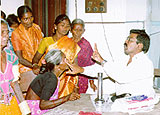|
 The change of government is an opportunity to discard outdated ideas and policies and bring in fresh ones. The UPA government has that window of opportunity but only for a few months. Sooner than one realises, the honeymoon will be over; anti-bodies will develop and innovations will become harder and harder to introduce. The change of government is an opportunity to discard outdated ideas and policies and bring in fresh ones. The UPA government has that window of opportunity but only for a few months. Sooner than one realises, the honeymoon will be over; anti-bodies will develop and innovations will become harder and harder to introduce.
The new government is banking on better education, agricultural growth and a new industrial policy to rectify matters. Education is a tool and not a product. It can amplify a person's capability to work but cannot create work to any significant extent. Its influence on income and other disparities is ambiguous: At times, it increases disparities and at times, it reduces them. As in the case of education, too much is expected of agriculture. According to the 55th Round of the National Sample Survey, in 1999-2000, there were around 45 million agricultural labour households with an average annual consumption expenditure of about Rs22,000, less than Rs5000 per capita, and barely 30 per cent of the national average. Five years hence in 2009, per capita incomes would have gone up at least 60 per cent above the 1999 figure. Then, wages of agricultural labour should increase at least five times to come on par with the rest of the population. There is no way that agricultural incomes can rise that high. It appears that agricultural labour is destined to wallow at the bottom of the economic pyramid. However, there is one way out: reduce the number of agricultural labourers by five. Most other rural labour and small farmers too are almost as poor as agricultural labour. They too should quit agriculture. Then, over the next five years, we will have to quadruple employment in industry and services, at the least double such employment or work for a 20 per cent growth rate of employment in industry and services. In manufacturing industry, as we move from hand tools to power tools to machine tools to computer driven numerical control machines to robotics, productivity, reliability, quality and competitiveness increases. Employment per unit of product decreases in the same proportion. Hence, in a globally competitive economy, industry cannot contribute significantly to the growth of employment. In contrast, in services, the larger the numbers employed, the better will be the quality of services: taxis offer better service than buses; restaurants with waiter service are better than fast-food restaurants; smaller classrooms are better than large ones. Thus, in direct contrast with industry, the quality of services increases as the numbers employed in providing a given service increase. Hence, the real hope for new jobs is in services, not in industry.  Currently, the net capital formation is about Rs.300,000 crores a year. As we are unable to create even one crore jobs a year, the capital required on the average to create one job is more than Rs300,000, nearer Rs400,000. We need 10 million new jobs a year to employ the increasing workforce; we should transfer at least another 10 million from farms to services to reduce rural-urban disparity. Currently, the net capital formation is about Rs.300,000 crores a year. As we are unable to create even one crore jobs a year, the capital required on the average to create one job is more than Rs300,000, nearer Rs400,000. We need 10 million new jobs a year to employ the increasing workforce; we should transfer at least another 10 million from farms to services to reduce rural-urban disparity.
It appears we need more capital than we have to engineer faster and better growth. Alternately, we may improve the productivity of capital. Incremental Capital-to-Output Ratio (ICOR) is the accepted measure of the productivity of capital. Currently, ICOR is about four in India. We should aim to reduce ICOR to no more than three. The present cost of investment is artificially inflated because most development is concentrated in expensive cities but not in villages where the purchasing power of money is greater. In villages, land can cost ten or even a hundred times less. Cheaper construction techniques can be adopted. Many services like water harvesting, waste disposal cost less. It is possible to have worker residences within walking distance of the workplace. Hence, all other factors being the same, in villages, ICOR will be less, as little as half that in cities. That is, other matters being equal, with a given amount of capital, villages can generate twice the number of jobs cities can. In practice, that does not happen; a city with a population of a hundred thousand creates many more jobs, all in the non-farm sector, than does the same population distributed over a score of villages. Though, in theory, villages are cheaper, entrepreneurs prefer to invest in costly cities. They do so because they need for their survival a variety of infrastructural support, which only cities provide and villages do not. Cities offer connectivity, mainly physical or transport connectivity that brings together large numbers of customers to support large markets, large both in size and in variety. Villages do not have connectivity; they cannot support large markets. All connectivity require a minimum customer base to be viable and profitable. The larger the customer base, the greater the variety that the market will support, the larger the employment it will create. For instance, in Mumbai, a number of dabbawalas make a living carrying lunch from workers' homes to their place of work. Such jobs are unthinkable in villages, not even in smaller cities. Hence, although in theory, villages cost less, investment there is unviable because demand is too little. If there is one criticism that can be levied against Indian policymakers, it is that they never had a cogent policy for demand generation. In India, the value of a project is measured by how much it costs, not by how much it produces, let alone how large a market it supports. On the one hand, large cities offer large connectivity (both in quantity and in variety) but costs are high. On the other, costs are low in villages but their customer base is too small to support any but the most elementary commerce. Reducing costs in large cities is next to impossible. Hence, the only alternative is to raise, somehow or other, the customer base that rural markets provide. President Kalam has been advocating the scheme PURA - Providing Urban amenities in Rural Areas - as a solution to this problem. PURA starts with the construction of a ring road linking a loop of villages and the establishment of frequent bus services. With both in places, every point on the ring road gets a large customer base equal to the total population of all villages on the loop. In other words, merely building a ring road and running bus services, converts this rural space into a virtual large town or small city capable of supporting a wide variety of services the way large towns do. The habitation may not extend beyond two to five hundred metres on either side of the ring road and yet it can ultimately house a couple of hundred thousand people with well-spaced houses. The ring road configuration cuts by half the length of all types of infrastructure - roads, water pipes, sewage drains, electricity lines, telecom cables, street lights and so on. It makes it possible to locate worker residences close to their place of business - ideally, eliminate daily commuting to work with all its financial, time, social and psychological costs. Water harvesting is simple, and so is waste disposal. Overall, the cost could be less than half of housing the same number by expanding a large city. However, the ring road and bus services tackle only one side of the problem of rural development: they reduce the cost of supply but do not ensure that customers are rich enough to demand goods and services as well as urban dwellers do. In this respect, agriculture-based villages suffer from an inherent defect that forces them to remain poor. The reason lies in the nature of prosperity. As prosperity increases, the pattern of demand changes; customers look for a larger variety of goods most of which cannot be made locally and will have to be imported. Matching exports are needed to pay for those imports. Thus, the higher the prosperity, the larger will be the demand for goods (and services) produced outside the community and the larger the requirement for exports of goods (and services). As agriculture is a low price good, agriculture-based villages cannot export much; they can neither import much. They are condemned to remain poor. Then, to match what cities do, PURA needs a two-pronged approach: ring road plus bus services to make the supply side more efficient, and a prosperous export sector to pay for the goods and services that prosperity demands. Only modern industry can provide that export business. Therefore, before a PURA is initiated, there should be a tie-up with industrial entrepreneurs who contract to invest in PURA, and create new and high-paying jobs in exports.  Such well-paid employees, provided they stay in PURA, will generate new customer demand directly. They will also multiply jobs by demanding housing, electricity, water supply, sanitation, new schools, health centres, entertainment, domestic help and a variety of such services. Once both the direct employment and indirect ones take root, demand will rise to support larger and larger markets. Such well-paid employees, provided they stay in PURA, will generate new customer demand directly. They will also multiply jobs by demanding housing, electricity, water supply, sanitation, new schools, health centres, entertainment, domestic help and a variety of such services. Once both the direct employment and indirect ones take root, demand will rise to support larger and larger markets.
However, such a virtuous development will take place only when the employees of the new industries live in PURA and do not commute from large cities - the way it happens in industrial satellite towns like Hosur and Faridabad. If well-paid employees do not reside in PURA, the demand they generate will be transferred to wherever they stay and will not go to PURA. The government has two options: It can take the conventional route, expand large cities and allow them to monopolise large businesses to the exclusion of rural areas. That will keep ICOR high because large cities are intrinsically expensive. It will also increase rural-urban disparity still further because villages will be left only with agriculture, which cannot grow as rapidly as industries and services do. On the other hand, the government can tread a new path, and transfer as much of new industry, new industrial housing and related services to rural areas. Costs can then be halved, and for a given amount of financial investment, output and growth can be doubled with a corresponding increase in jobs created. As a bonus, rural-urban disparity will decrease. The shift of emphasis from agriculture to industry and services will require more vocational training. In place of vocational training, current fashion emphasises liberal education that makes most graduates unemployable. There is an urgent need to restrict college admissions to the numbers that can find jobs, and no more. Then, half the college courses may have to close. So be it. Master crafts-persons and not bookish teachers are best equipped to offer vocational training. The workplace too is better equipped to do so than classrooms, or school workshops. Then, a sandwich programme, with students alternating every week between classroom teaching and vocational practice under master crafts-persons, will offer a workable compromise between education and employability. Such a system will place the onus on employers to provide vocational training. Ultimately, it is in their own interest to do so. Even then, because such training is a social good, employers deserve some reward for offering vocational training. Low-cost credit is the simplest and the most effective reward for employers. It will cost the government practically nothing but will help employers, particularly small businesses, a great deal. Rapid growth is not a good economic remedy by itself unless it is evenly distributed. Shifting modern industry, services and housing for employees from expensive cities to rural areas is a good way of distributing the fruits of growth. We will then get an added benefit: ICOR will come down and the growth rate will increase. For decades, we have tried agricultural subsidies, artificial support to dying industries, legal protection to unwanted labour, huge investments to make large cities liveable, and many other populist schemes without success. The government has a small window of opportunity to experiment with something new. What innovations the Prime Minister introduces in the next few months will determine his place in history. *(The author is former director,IIT Madras) |